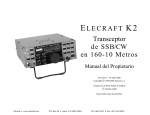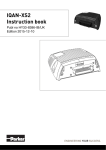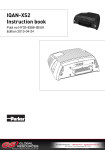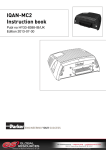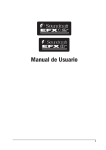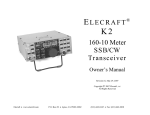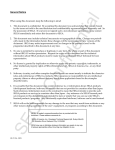Download ELECRAFT KAF2 Operating instructions
Transcript
Construction Manual for the K2DI v.III, Digital Interface and K2DI-PCI, Computer’s Interface by Paulí Núñez, EA3BLQ Revision June, 2005 Page 2 This page is left blank on purpose Construction Manual for the K2DI v.III and K2DI-PCI boards © EA3BLQ - Revision June 2005 Page 3 INDEX Foreword ..................................................................... 3 K2DI v.III Digital Interface ............................................ 4 Picking the received AF signal up from P2 at the KAF2 or KDSP2 boards .............................................................. 9 K2DI-PCI Computer Interface....................................... 10 Pictures and Schematics .............................................. 15 How to install the separators ........................................ 25 Schematics ................................................................ 29 FOREWORD: This document could be considered as the 4th and last installment of my Digital Interface Saga. The other three installments or episodes being: “K2 Digital Interface v.I”, “K2 Digital Interface v.II.2” and “DI v.II.2 installed into the K2/100”. For those of you who do not know it; let me succinctly explain this part of the story. If you already know it and think I am being too repetitive, please accept my apologies and thanks for your bearing with me. It was back in summer 2002, when Elecraft launched the KAF2 option, -latter on they launched the KDSP2 as a DSP filter alternative to the KAF2-, when I discovered that my DI v.II.2, Digital Interface, could not be installed into a Complete Basic K2, featuring all the options: KDSP2 or KAF2, KAT2, KIO2 and KBT2, nor into the Integrated K2/100, because in neither of the two set-ups there was any free space available for my PCB. At the time it could only be installed in a NO KAF2 or NO KBT2 configuration of the K2 as explained in the K2 Digital Interfacev.II.2 PDF file. From that moment on I promised myself I had to find a way out of this “cul-de-sac”. It was a personal defy I had to overcome. From time to time I gave a thought to the challenging problem and it was by mid November 2003 that I was suddenly struck with new ideas that gave rise to a new design of my Digital Interface, the K2DI v.III. When I tested the prototype board, a new idea gave birth to the design of the K2DI-PCI, Computer Interface, as an optional daughter board of the DI. The boards are silk-screened and double sided with plated-through holes, as usual. The main features of both circuits are explained in the forthcoming pages of this document. Construction Manual for the K2DI v.III and K2DI-PCI boards © EA3BLQ - Revision June 2005 Page 4 K2DI v.III Digital Interface Main features: • The circuit is the very same as the one used in v. II.2 but for an outlet of 5VDC that has been added to supply voltage to the K2DI-PCI. The board has been redrawn to a much smaller size: 59 mm (2 5/16") x 35 mm. (1 3/8"). • Its features include the Microphone Configuration Extender as well as a buffered, fixed audio output and the cutting of the Front Panel microphone connector's AF and PTT lines when transmitting data, so as to avoid the unwanted transmission of shack noise through a live microphone. • This board may be used as a stand alone Digital Interface by connecting J3 to a Mini Din connector at the rear K2 panel, or as a mother board for the K2DI-PCI. How it works: Microphone Configuration Header Extender All pins of J1 and J2 are connected in parallel except for the AF and PTT lines, which are connected in parallel only while the K2 is in standby or reception mode but are cut while transmitting digital data, as explained further on. Through the ribbon cable, J1 receives and sends signals from and to the Microphone Configuration Header at the Front Panel board and because of the parallel connection of J1 and J2, J2 becomes an extension of the aforementioned Configuration Header. Thus J2 is the header where you are to configure the Front Panel Mic Connector in accordance with your microphone’s wiring and needs. Buffered, fixed audio output: The received audio is fed to J4 either from Aux Audio J5 at the K2's RF Board or from pins 1 and 2 at P2 on the KAF2 or KDSP2 board. Although I don't see any inconvenience to feed the AF signal by taping P2 at the KAF2 or KDSP2, instead of J5 at the RF board, so as to take advantage of the filters, this is the user's choice. In any case, care must be taken not to tape and connect the wrong pins to J4 at K2DI board. P2 at the KAF2 and KDSP2 has the GND signal at pin 3, while J4 at K2DI and J5 at the K2's RF board have the GND signal at pin 2. An error when identifying the pins would produce a short. To prevent this I have modified the P2 three pins male header so that when installed, I get the normal 3 pins male header on the bottom side of the board while I also get a 2 pin male header on the top side (pins 1 and 2). Further on this document you’ll find pictures showing this mod. For consistency sake, I decided to copy the Elecraft's original K2 Audio Amplifier circuit to feed U2, the AF amplifier (LM386N) and to control its audio level. The use of a couple of J310 FET (Q1 and Q2), biased through a 3.3 MOhm resistor, as in the K2, is very useful as it allows the disconnection of the AF amplifier from the product detector when on data transmission. Construction Manual for the K2DI v.III and K2DI-PCI boards © EA3BLQ - Revision June 2005 Page 5 Cutting the Front Panel mike connector's AF and PTT lines and muting the AF amplifier, when transmitting data: Due to its low current drain and its switching features, I've chosen the use of a CD4053BE CMOS Analogue Multiplexer to cut and commute the AF and PTT lines from the Front Panel Microphone Connector, through J1, to the Rear Digital Connector when transmitting data, and to disconnect U2, the audio amplifier LM386, from the product detector by grounding the gates of Q1 and Q2, following Elecraft's design. K2DI STANDBY (Receive) POSITION The K2DI circuit schematic (see page 29) shows the device in its standby (receive) position, by default, the multiplexer mosfets are biased high due to pins 9, 10 and 11 of U1, CD4053BE CMOS, being fed with 5V DC through R3 (a 10K resistor). In this way we have: a) The ground connected at pin 14 of U1 (a) goes nowhere as pin 13 has no connection. b) The outgoing microphone signal from the AF pin at J2 goes to the AF pin in J1 through pins 15 and 1 of U1 (b), as both AF pins are contacted in parallel, and c) The signal from the PTT pin at J1 goes to the PTT pin at J2 through pins 4 and 3 of U1 (c), connecting the PTT pins in parallel too and thus enabling the Front Panel AF and PTT lines. Because of the DC component (2.5 V fed through R1 and R2) present in the U1 (b), three 10 µF electrolytic capacitors (one inlet and two outlets of U1) are needed to decouple the DC from the signal. K2DI DIGITAL TRANSMIT POSITION When, because of data transmission, the PTT is keyed through the Rear Data Connector or by means of the K2DI-PCI Serial or Tone (VOX) circuits, pins 9, 10 and 11 of U1, CD4053BE, are grounded through pin 3 at J3. Then the voltage at those pins drops to 0 V., setting the multiplexer mosfets low and thus three switching operations are activated: 1) U1 (a) - Switches pin 14 from pin 13 to pin 12 and grounds the gates of Q1 and Q2, setting them low and thus disconnecting the AF amplifier. 2) U1 (b) - Switches pin 15 from pin 1 to pin 2, connecting the outgoing digital signal received from the computer’s soundcard through pin 1 of J3, and coming from pin 1 of the MiniDIN connector or from pin 1 of P1 at the K2DI-PCI board, to the AF pin at J1 and thus to the K2 TX circuitry. The unwanted mic signal coming from the AF pin at J2 (if any) is cut and has no way out. 3) U1 (c) - Switches pin 4 from pin 3 to pin 5, keying the rig by grounding the PTT pin at J1 and disconnecting the microphone PTT line at J2 CAUTION: • Avoid triggering the K2 PTT through the KI/O2 by means of a program’s CAT facility. If you do, the K2DI v.III WILL NOT be activated and the Digital transmission WILL NOT take place. Construction Manual for the K2DI v.III and K2DI-PCI boards © EA3BLQ - Revision June 2005 Page 6 K2DI v.III Parts List DESIGNATORS VALUE C1, C2, C3, C4, C10 C5 C8 C10 C6 C7, C9 J1 J1 and Microphone. Configuration Header at Front Panel board J2 J4 J5 at the RF board J4 & J5 at RF board J4 and J5 at RF board Q1, Q2 R4 R3 R1, R2 R5 R6 (*) R7 DESCRIPTION QTY 10µF 16/25v 220µF 16/25v .01 .022 .047 .1 Right angle dual row header IDC Female connector for flat cable. Electrolytic or tantalum capacitor Electrolytic capacitor Capacitor "103" Capacitor “223” Capacitor "473" Capacitor "104" 16 pin male FC-16P (16 pin female dual row) 5 1 1 1 1 2 1 2 Dual-row header Connector with locking tab Male header Housing Hardware J310 2.7 Ω 10K 100K 3.3 MOhm 2K POT 3329H202 or T7YB 220 Ω 1 1 1 2 6 2 1 1 2 1 1 1 1 U1 U2 J2 Separators Separator Separator Separators Screws Screws Nuts Washers J1 at K2DI and Mic. Configuration Header at the K2’s Front Panel Brd. Dig. Interface v.III CD4053BE or HEF4053BP LM386N Hardware Hardware Hardware Hardware (1) Hardware Hardware Hardware Hardware Hardware Miscellaneous 16 pin male 3 pin male 3 pin male 3 pin female Female crimp pins for the housings FET TO-92 Resistor (red-violet-gold) Resistor (brown-black-orange) Resistor (brown-black-yellow) Resistor (orange-orange-green) Trimmer pot for audio level adjustment Resistor (red-red-brown) See text for comments on R7 (*) CMOS (16 pins) Low Voltage Audio Amplifier (8 pins) Mic Conf. Header Extender Jumpers Male-female hexagonal 1.8cm. Male-female hexagonal 1.5cm. Female-female hexagonal 1.5cm. Male-female hexagonal 7mm M3 pan head screws 4mm. M3 pan head screws 6mm. M3 nuts Split Lock washer 15.5 cm. flat ribbon cable 16 wires Miscellaneous Printed Circuit Board J3 J3 J3 MiniDIN Connector Male Connector with locking tab Housing Hardware Miscellaneous 1 1 8 2 1 1 3 4 4 4 4 1 PCB used as a stand alone Digital Interface 4 pin male 4 pin female Female crimp pins for the housing 4 pin panel MiniDIN connector 1 1 4 1 PCB used as mother board for the K2DI-PCI board J3 J5 Male header Male header 4 pin male 2 pin male 1 1 Picking the AF up from P2 at the KAF2 or KDSP2 boards P2 at KAF2 or KDSP2 P2 at KAF2 or KDSP2 P2 at KAF2 or KDSP2 P2 at KAF2 or KDSP2 (1) Special Male-male header Housing Locking tab Hardware 3 and 2 pin 2 pin female 2 pin male Female crimp pins for the housing 1 1 1 2 To be used only in case the KBT2 option is installed. (See pictures section) Construction Manual for the K2DI v.III and K2DI-PCI boards © EA3BLQ - Revision June 2005 Page 7 ASSEMBLY INSTRUCTIONS: Please note that all the soldering rules, warnings and tips you have learned and used when assembling your K2, are to be applied in the assembly of this circuit too. Install and solder components in the following order: a) _R1, _R2: 100K resistors (brown-black-yellow) b) _R3: 10K resistor (brown-black-orange) c) _R4: 2.7Ω resistor (red-violet-gold) d) _R5: 3.3 MOhm resistor (orange-orange-green) e) _R6: 2K trimmer pot (3329H202 or T7YB). By factory default, the trimmer pot is usually set to its midpoint [+/- 1 Kohm] Once installed, setting R6 clockwise (CW) will increase the resistance and thus the volume level of the signal fed to U2 (LM386 audio amplifier). Obviously, to decrease the volume, R6 is to be set counterclockwise (CCW). f) _R7: 220Ω resistor (red-red-brown) * See text bellow for notes on this resistor. g) _C6: 0.047µF (473) capacitor h) _C7, _C9: 0.1µF (104) capacitors i) _C8: 0.01µF (103) capacitor j) _C10: 0.022µF (223) capacitor k) _Q1, _Q2: J310 FET l) _J1: Dual row right angle header (16 pin male) m) _J2: Dual row header (16 pin male) n) _J3: Connector w/locking tab (4 pin male), if K2DI v.III. is used as a stand alone board. A 4 pin male header when K2DI is used as a motherboard in conjunction with the K2DI-PCI o) _J4: Connector w/locking tab (3 pin male) p) _C1, _C2, _C3, _C4, _C11: 10µF 16/25v electrolytic capacitors q) _C5: 220µF 16/25v electrolytic capacitor. If the K2DI-PCI board is to be installed, please bend the leads so that the capacitor is installed resting on its side on the PCB. r) _U1: CD4053BE or HEF4053BP CMOS (16 pins) s) _U2: LM386 low voltage audio amplifier (8pins) Construction Manual for the K2DI v.III and K2DI-PCI boards © EA3BLQ - Revision June 2005 Page 8 (*) NOTES ON THE R7 RESISTOR'S VALUE TO CONTROL LM386's GAIN. The manufacturer's General Description of the LM386 reads: "…The gain is internally set to 20 to keep external part count low, but the addition of an external resistor and a capacitor between pins 1 and 8 will increase the gain to any value up to 200." The factory default gain of ±20, attained through the inner 1.35Kohm resistor allocated between pins 1 and 8 is too low for our needs. On the other way if we externally bypass that resistor by inserting a 10µF electrolytic capacitor between those pins (+ lead to pin 1) the gain is increased to 200. Good enough to drive a 4Ω speaker but too high for the sound card, as it gets overdriven. On this account and by inserting one external resistor in parallel with the inner resistor and in series with the electrolytic capacitor, between pin 8 of the IC and the (-) lead of the capacitor, we may set that gain to the level that meets with our needs, within the range of 20-200. As a result of some computing, I've got the following options for R7's resistor value: 1) One 1.2Kohm resistor (brown-red-red) will render a gain of about 50 (perhaps a bit on the low side) 2) One 330Ω resistor (orange-orange-brown) will render a gain of about 75 3) One 220Ω resistor (red-red-brown) will render a gain of about 90. 4) One 180Ω resistor (brown-grey-brown) will render a gain of about 100 and 5) One 100Ω resistor (brown-black-brown) will render a gain of about 125 I have chosen option #3, but the builder may choose the option he/she thinks most suitable for his/her needs and/or preferences. CAUTION: • Please, remember to configure J2 header (the microphone configuration header extender) in accordance with your mic needs, as per Table 2 on the Elecraft’s “Assembly and Operating Instructions” for the KSB2 SSB Adapter: “P1 Wiring for Selected Microphones”, as you would do on the Microphone Configuration Header at the Front Panel board itself. • If your intention is to construct the K2DI-PCI board too, then it is most convenient to set up the mic configuration at this step, before constructing and assembling the K2DI-PCI daughter board to the K2DI v.III board. If you fail to do so you may forget this step and be compelled to undo the K2DI v.III / K2DI-PCI assemblage so that you can reach the J2 header at the K2DI. Construction Manual for the K2DI v.III and K2DI-PCI boards © EA3BLQ - Revision June 2005 Page 9 Picking the received AF signal up from P2 at the KAF2 or KDSP2 boards Caution: If you, to take advantage of the filtering provided by either circuitry of the KAF2 or KDSP2 devices and/or because the connection for the K2DI v III.2 is handier, decide to pick the received AF signal up from the P2 connection at the KAF2 or KDSP2 boards, instead of picking it up from the auxiliary AF connection provided at J5 on the RF board, please bear in mind the following facts: a.- In both cases the K2’s audio circuit is the very same balanced one, but b.- On the RF board, the 3 pin distribution at J5 correspond to pins 1 and 3 for the audio lines and GND is connected to pin 2. c.- On the KAF2 or KDSP2 boards, the 3 pin distribution at P2 correspond to pins 1 and 2 for the audio lines while the GND connection is located at pin 3. Obviously the 3 pin female connector you may prepare to connect J4 at the K2DI to J5 on the RF board cannot be used for connection to P2 on the KAF2/KDSP2 boards. It would produce a short. To avoid this risk I have prepared the special male-male header shown on the image at the right, which is to substitute the one provided by Elecraft with either of their devices. Should you have the original P2 header already installed you are to desolder it taking outmost care in the process so as not to damage the soldering pads. The square soldering pad, near the down board’s edge, corresponds to pin 1. The special header is to be introduced for installation into the KAF2 or KDSP2 through the bottom side of the board, taking care to position its pin 1 through the square soldering pad. Check before soldering. The 3 equal pins with the plastic holder go on the bottom side. (See pictures below) Soldering is done on the top side of the board. Before soldering check the header’s positioning once again and, if it is ok, solder only pin 3. Check the positioning once again and see that the plastic holder is flush with the board and that the pins are perpendicular to the board and parallel to those of P1. If any correction is necessary please do so by reheating the pin 3 solder. If it is ok please go on soldering pins 1 and 2, but taking care to use a minimum amount of solder, just the necessary to secure a good contact between the board and the pin. Use a magnifying glass to check the joints. Once finished soldering please prepare the locking tab by cutting out the borders of the indents at its bottom to allow more contact field for the pins and perhaps you will have to shorten its base by a couple millimeters to allow it to sit flush on the board when installed in the two pins. Special header installed w/o locking tab. Locking tab installed. Showing tab and pin 3 (GND) solder. This pick up set-up also applies for the KAF2 audio filter board. Construction Manual for the K2DI v.III and K2DI-PCI boards © EA3BLQ - Revision June 2005 Page 10 K2DI-PCI Computer Interface Main features: • The board measures 73 mm (2 7/8") x 35 mm (1 3/8"). • Its circuitry (see the schematics on page 29) features a Serial Port (RTS and DTR) PTT or a VOX (Tone) PTT, to be chosen by the user when setting the J3 and J4 jumpers in accordance with his/her needs and/or preferences. • The Serial Port is isolated by an optocoupler. • The Line In/Mic or Line Out/Spkr soundcard connection is isolated by two 600:600Ω coupling transformers (Atech ATS-075), which feature a very flat response and an Insertion Loss of 1.0 dB Max at 1 Khz 1 Vrms. • One 10K POT controls the AF In audio volume level. • A connection for an optional PTT ON Led is provided, to be installed in case this board is used as an external stand alone computer interface. • This board has been designed to be the K2DI's daughterboard but, as I have pointed out, it also can be used as a stand alone external Computer's interface. How it works: PTT SWITCHING The PTT circuit provides the possibility of using any of two modes of PTT switching: either Serial (RS232) PTT or VOX (Tone) PTT, depending on the user’s choice or needs. Many a program for digital communications (PSK31, SSTV, etc.), when setting-up the PTT switching option, allows the user to choose either Serial COM port or Soundcard/VOX and, when choosing the former, you can even choose the use of the RTS, DTR or both RTS & DTR signals. Serial (RS232) PTT This mode features the use of an Optically Coupled Isolator, the 4N32, to achieve the switching of the PTT while maintaining a very good isolation between the rig and the computer. This Optocoupler (U1 on the schematic) is driven when any or both pins RTS and/or DTR of a Computer’s Serial (RS232) connector (pins 4 and 7 on a DB9 and pins 4 and 20 on a DB25) are biased high (±5 vDC). When this happens the 4N32’s inner infrared LED (pin 1 anode and pin 2 cathode) biases the photo sensor base so that the collector (pin 5) and the emitter (pin 4) become conductive and grounds the PTT line on pin 3 at P1, thus switching the PTT circuit on. Pins 1 and 2 at J4 must be jumpered. J3 must be open. VOX (Tone) PTT This circuit uses a Low Power Dual J-FET Operational Amplifier, the TL062 (U2 on the schematic), and consists of two sections with different functionality: In the first section (U2 a) a square wave signal is obtained from the AF signal coming from the TR1 secondary and fed to pin 2. When the tension level on pin 2 is higher that that on pin 3, the output on pin 1 will be at 0 (zero) volts level, and vice versa, when the tension level on pin 2 is lower than that on pin 3, the output level on pin 1 will be that of ±5 vDC. Construction Manual for the K2DI v.III and K2DI-PCI boards © EA3BLQ - Revision June 2005 Page 11 In this way pin 1 will render a square wave signal whenever there is an AF signal fed to pin 2. In the absence of such an AF signal the output will be 0 (zero) volts. Because of this, whenever there is an AF signal fed to pin 2, the 1N4148 (D3) diode rectifies the square wave signal present at pin 1 and charges the C5 capacitor at 5 vDC. The values of the conjunct R7 and C5 determine the time constant, when the capacitor will remain charged. While C5 is charged, the second section (U2 b) will render 5 vDC on its outlet at pin 7. When, because there is no AF signal at pin 2, C5 gets discharged, there will be 0 (zero) volts present at pin 7. The tension present at pin 7, through R5 biases Q1 which emitter and collector become conductive and drive the PTT switch by grounding pin 3 at P1. Pins 2 and 3 at J4 as well as those of J3 must be jumpered. Soundcard isolation The soundcard’s Line In/Mic and Line Out/Spk are isolated from the circuit by a couple of 600:600 Ω audio coupling transformers by Atech Technology Co. Ltd., the ATS-075, which offers a very flat response and a very low profile. AF In level So as not to overdrive the transmitter and to prevent IMD, the level of the audio fed to the K2 for transmission may be set by means of the 10K trimmer potentiometer R2. CAUTION: • If and when using the VOX (Tone) PTT option, care must be taken to mute, at your OS, all the sounds and chimes scheduled to announce Windows’ and other program’s events or happenings (Start -> Configuration -> Control Panel -> Sound, Audio and Voice Devices -> Change Sound Scheme -> Properties -> Sound). It is MOST IMPORTANT that no unwanted sound is produced. Otherwise, those sounds will inadvertently trigger the PTT and, to our own despair and annoyance or what is more embarrassing, to that of the contacted remote station or the listeners, the unwanted sound will be transmitted. • If your Sound Card has the full duplex feature, when setting the Sound Card Mixer, remember to mute the Line In or Microphone In at the Sound Level Control, so that the received audio or noise is not echoed to the Line Out outlet and thus get the PTT switched On continuously. Construction Manual for the K2DI v.III and K2DI-PCI boards © EA3BLQ - Revision June 2005 Page 12 K2DI-PCI Parts List DESIGNATORS VALUE DESCRIPTION QTY C1 C5 C3, C4 C2 D1, D2, D3 J1 J1b J2 J2b J3 J4 LED1 P1 P2 Q1 R1, R3 R5 R2 R4, R7 R6 R8 TR1,TR2 U1 U2 J1b & J2b J3, J4 Separators .1µF .47µF 4.7µF 10µF 1N4148 Connector with locking tab Housing Connector with locking tab Housing Male header Male header LED Female Header Female Header PN2222A or MPS2222A 470 Ohm 10K 10K POT (Miniature) 100K 3.3M 1K Transformer 4N32 TL062 Hardware Hardware Hardware 1 1 2 1 3 1 1 1 1 1 1 1 1 1 1 2 1 1 2 1 1 2 1 1 7 2 3 Lock Washers MiniDin Conn. MiniDin Conn. K2DI-PCI Hardware Hardware Hardware Miscellaneous Capacitor "104" Capacitor "474" Electrolytic or tantalum capacitor Electrolytic or tantalum capacitor High speed diode 3 pin male 3 pin female 4 pin male 4 pin female 2 pin male (PTT jumper) 3 pin male (PTT jumper) red LED 4 pin female 2 pin female NPN General purpose transistor Resistor (yellow-violet-brown) Resistor (brown-black-orange) Trimmer pot for audio level adjustment Resistor (brown-black-yellow) Resistor (orange-orange-green) Resistor (brown-black-red) Coupling transformer Atech ATS-079B Optocoupler Dual operational amplifier Female crimp pins for the housings PTT Jumpers Female-female hexagonal 1cm. separators Split Lock Washers 4 pin Chassis MT MiniDin to Sound Card 3 pin Chassis MT Mini Din to RS232 Printed Circuit Board 3 1 1 1 MOUSER 652-3329H-1-103 421-ATS079B 161.2104 161,2103 Construction Manual for the K2DI v.III and K2DI-PCI boards © EA3BLQ - Revision June 2005 Page 13 ASSEMBLY INSTRUCTIONS: Please note that all the soldering rules, warnings and tips you have learned and used when assembling your K2, are to be applied in the assembly of this circuit too. Install and solder components in the following order: a) _R1 _R3: 470 Ω resistors (yellow-violet-brown) b) _R8: 1K resistor (brown-black-red) c) _R5: 10K resistor (brown-black-orange) d) _R4, _R7: 100K resistors (brown-black-yellow) e) _R6: 3M3 resistor (orange-orange-green) f) _D1, _D2, _D3: 1N4148 High speed diode g) _C1: .1µF capacitor (104) h) _C5: .47µF capacitor (474) i) _C3, _C4: 4.7µF electrolytic or tantalum capacitor j) _C2: 10µF electrolytic or tantalum capacitor k) _P1: 4 pin female header (to be installed on the bottom side of the board and soldered on the top) (*) l) _P2: 2 pin female header (to be installed on the bottom side of the board and soldered on the top) (*) m) _R2: 10K POT trimmer n) _Q1: NPN General purpose transistor (PN2222A) o) _U1: Optocoupler (4N32) p) _U2: Dual operational amplifier (TL062) q) _LED1: Optional PTT on LED (red). Useful if the board is installed as a stand alone External Computer Interface. r) _TR1, _TR2: 600:600Ω Coupling transformer (Atech ATS-075). Mouser’s catalogue part # 421-ATS075 (page 542) s) _J1: Connector with locking tab (3 pin male) t) _J2: Connector with locking tab (4 pin male) u) _J3: Header (2 pin male) v) _J4: Header (3 pin male) (*) Should the board be used as a stand alone External Computer Interface, these two female headers ought to be substituted by a 4 and 2pin male connectors installed on the top face of the board and soldered on the bottom. Construction Manual for the K2DI v.III and K2DI-PCI boards © EA3BLQ - Revision June 2005 Page 14 This page is left blank on purpose Construction Manual for the K2DI v.III and K2DI-PCI boards © EA3BLQ - Revision June 2005 Page 15 Pictures Construction Manual for the K2DI v.III and K2DI-PCI boards © EA3BLQ - Revision June 2005 Page 16 K2DI v.III XRay image K2DI V.III Parts Placement Construction Manual for the K2DI v.III and K2DI-PCI boards © EA3BLQ - Revision June 2005 Page 17 K2DI V.III Constructed and ready to be installed K2DI v.III installed on the top cover of the K2 Construction Manual for the K2DI v.III and K2DI-PCI boards © EA3BLQ - Revision June 2005 Page 18 K2DI-PCI PCB’s x-ray image K2DI-PCI Parts Placement Construction Manual for the K2DI v.III and K2DI-PCI boards © EA3BLQ - Revision June 2005 Page 19 Constructed K2DI-PCI ready to be installed K2DI-PCI fitted on top of its motherboard, the K2DI v.III Construction Manual for the K2DI v.III and K2DI-PCI boards © EA3BLQ - Revision June 2005 Page 20 Side view of the installed PCBs KF2 with modified 3 pin male header Construction Manual for the K2DI v.III and K2DI-PCI boards © EA3BLQ - Revision June 2005 Page 21 KDSP2 Board. Mind the 2 pin header on the top K2DI-PCI board showing the female headers placed on the bottom Construction Manual for the K2DI v.III and K2DI-PCI boards © EA3BLQ - Revision June 2005 Page 22 Ribbon cable connected to the Front Panel Mic Configuration Header Side view of the K2, showing the ribbon cable coming out between the Control and Front Panel boards, the KDSP2 option and the installed K2DI v.III & K2DI-PCI boards. Mind the J1 and J2 straight connectors at the K2DI-PCI board. Right angled connectors collided with the Side Panel. Construction Manual for the K2DI v.III and K2DI-PCI boards © EA3BLQ - Revision June 2005 Page 23 The ribbon cable connected to the K2DI v.III Digital Interface How the Serial PTT and Soundcard cables are fixed to the top cover Construction Manual for the K2DI v.III and K2DI-PCI boards © EA3BLQ - Revision June 2005 Page 24 I have used a Minijack stereo for the Serial PTT rear connection and have isolated the PC signal GND with one bakelite washer. The jack is centered in the former OUT XVTR hole. Construction Manual for the K2DI v.III and K2DI-PCI boards © EA3BLQ - Revision June 2005 Page 25 How to install the separators The separators as well as the screws and nuts I provide are Metric 3 and because of that and for esthetic consistency sake, I suggest that, when installing the board(s) on the top cover of the K2, the constructor uses them instead of using the hardware supplied by Elecraft (screws and bolts for the loudspeaker and malefemale separators for the KBT2) KBT2 Internal battery setup Substitute the screws, bolts and KBT2 Battery Bracket’s separators for the ones supplied with the K2DI v.III kit. Construction Manual for the K2DI v.III and K2DI-PCI boards © EA3BLQ - Revision June 2005 Page 26 NO Internal battery setup Construction Manual for the K2DI v.III and K2DI-PCI boards © EA3BLQ - Revision June 2005 Page 27 Construction Manual for the K2DI v.III and K2DI-PCI boards © EA3BLQ - Revision June 2005 Page 28 This page is left blank on purpose Construction Manual for the K2DI v.III and K2DI-PCI boards © EA3BLQ - Revision June 2005 Page 29 SCHEMATICS Construction Manual for the K2DI v.III and K2DI-PCI boards © EA3BLQ - Revision June 2005 Page 30 K2DI v. III K2 Digital Interface featuring a Mic. Configuration Header Extender and Rear Panel Data Connector (It Includes a buffered, fixed audio output and the cutting of Front Panel mic. connector's AF and PTT lines, when transmitting data). © Paulí Núñez, EA3BLQ - November 2003 J3 to MiniDIN conn. or to P1 at the K2DI-PCI 9 16 U1 (c) 1 AF C1 10 µF 3 4 AF 2 DN 3 UP 4 FUNC 5 10 U1 (b) + 5 PTT R2 100K CD4053BE PTT R1 100K 15 1 C2 10 µF + 2 C3 10 µF + 1 CD4053BE 6 7 8 2 MiniDIN connector (connections as seen from K2's rear panel) 3 R3 10K +5VDC (10mA max.) +5V 6 GND 7 J5 to P2 at K2DI-PCI + AF IN GND PTT AF OUT NC NC 4 C4 10 µF + C5 220 µF J310 8 GND 11 J1 to FP Board Mic. Config. Header 123456- 13 NC J2 Extended Mic. Config. Header R4 2.7 Ω U1 (a) CD4053BE 1 R5 3.3M 2 + 2 C8 0.01 C10 0.022 3 S D CW 8 5 7 4 C9 0.1 CCW J4 to RF Board, J5 U2 LM386N Q2 J310 3 R7* 220 Ω 6 1 G G G C11 10 µF C7 0.1 D Q1 J310 S C6 0.047 12 S D 14 NC R6 2K trimmer pot. Notes: All resistors are 1/4 watt and their value is in ohms; K = 1,000 and M = 1,000,000 Decimal values of capacitance are in microfarads (µF) NC = No connection See text for comments on R7* Construction Manual for the K2DI v.III and K2DI-PCI boards © EA3BLQ - Revision June 2005 Page 31 K2DI-PCI Sound card interface for the K2's K2DI by EA3BLQ Circuit for a daughter PC board of the K2DI v.III PCB, designed to interface the K2's DI with a computer. It features Opto isolation for the RS232 PTT circuit, as well as isolation for the sound card connections. Another remarkable feature is the possibility to choose the PTT mode between RS232 or VOX, according to user preferences. D1 1N4148 R1 470 Ω J1 RS-232 DB 9 1 6 2 7 3 8 4 9 5 4 - RTS 7 - DTR 5 - GND 1 2 D2 1N4148 U1 1 6 2 5 NC J4 PTT mode Jumper 3 3 4N27 4N32 4 NC 1 } Serial PTT (Do NOT jump J3) To P1 PTT Line (pin 3) } Tone PTT (J3 MUST be jumped) 3 R4 470 Ω 5 VDC R3 500 Ω To P1 AF In (pin 1) R2 10K C3 4.7µF TR1 5 VDC 5 VDC J3 2 -U2 (a) J2 Pin 2 Tone PTT Jumper C2 10µF + R8 100K + Digital PTT On LED (Optional) R9 1K 1 TL062 3 + C1 .1µF 8 5 D3 1N4148 4 R7 3M3 C5 ,47 µF 6 + - U2 (b) TL062 7 R6 10K B Q1 PN2222A BC546 J2 Pin 1 Atech ATS-075 600:600 + C4 4.7µF C E 5 VDC P2 R5 100K PC GND + TR2 J2 P1 To P1 AF Out (pin 4) J2 Pin 3 J2 Pin 4 Atech ATS-075 600:600 PC GND SCard's GND 1 AF In 1 SCard's Spkr/Line Out 2 GND 2 SCard's Mic/Line In 3 PTT 3 SCard's GND 4 AF Out 4 Notes: All resistors are 1/4 watt and their value is in ohms; K = 1.000 and M = 1.000.000 Decimal values of capacitance are in microfarads ( µF). NC = No connection. P1 connects to K2DI J3 P2 connects to K2DI J5 © November 2003 by Paulí Núñez, EA3BLQ Construction Manual for the K2DI v.III and K2DI-PCI boards © EA3BLQ - Revision June 2005 Page 32 Construction Manual for the K2DI v.III and K2DI-PCI boards © EA3BLQ - Revision June 2005

































